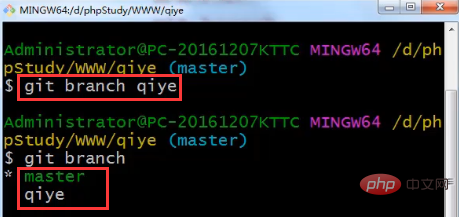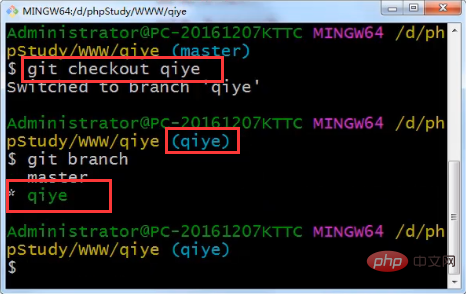How to switch branches in Git
This article mainly introduces how to switch branches in Git.
In the previous article, we introduced to you What is Git and How to create a Git branch.
I believe everyone has a certain understanding of Git branches. The so-called branch means that you can separate your work from the main development line so as not to affect the main development line.
So when we complete the task on a certain branch, how do we switch to another branch?
In fact, the method is also very simple.
Mainly use the following Git command statement to switch branches:
git checkout + 分支名称
Below we combine a simple example to perform the actual operation, that is, How to switch branches.
We open the Git command line interface in the specified directory, create branch qiye and view the branch.

As shown in the picture above, there are two branches here. And the current location is on the master branch.
Then if we want to switch to the qiye branch, we can switch through the git checkout method. The specific operations are as follows:

As shown in the figure, the master branch is successfully switched to the qiye branch.
This article is a detailed introduction to Git switching branches. It is very simple and easy to understand. I hope it will be helpful to friends in need!
The above is the detailed content of How to switch branches in Git. For more information, please follow other related articles on the PHP Chinese website!

Hot AI Tools

Undresser.AI Undress
AI-powered app for creating realistic nude photos

AI Clothes Remover
Online AI tool for removing clothes from photos.

Undress AI Tool
Undress images for free

Clothoff.io
AI clothes remover

AI Hentai Generator
Generate AI Hentai for free.

Hot Article

Hot Tools

Notepad++7.3.1
Easy-to-use and free code editor

SublimeText3 Chinese version
Chinese version, very easy to use

Zend Studio 13.0.1
Powerful PHP integrated development environment

Dreamweaver CS6
Visual web development tools

SublimeText3 Mac version
God-level code editing software (SublimeText3)

Hot Topics
 How to use git management tools for complete usage of git management tools
Mar 06, 2025 pm 01:32 PM
How to use git management tools for complete usage of git management tools
Mar 06, 2025 pm 01:32 PM
This article provides a guide to Git management, covering GUI tools (Sourcetree, GitKraken, etc.), essential commands (git init, git clone, git add, git commit, etc.), branch management best practices (feature branches, pull requests), and merge con
 How to push the specified commit
Mar 06, 2025 pm 01:39 PM
How to push the specified commit
Mar 06, 2025 pm 01:39 PM
This guide explains how to push a single Git commit to a remote branch. It details using a temporary branch to isolate the commit, pushing this branch to the remote, and then optionally deleting the temporary branch. This method avoids conflicts and
 How to solve the failure of git commit submission
Mar 06, 2025 pm 01:38 PM
How to solve the failure of git commit submission
Mar 06, 2025 pm 01:38 PM
This article addresses common Git commit failures. It details troubleshooting steps for issues like untracked files, unstaged changes, merge conflicts, and pre-commit hooks. Solutions and preventative measures are provided to ensure smoother Git wo
 The difference between commit and push of git
Mar 06, 2025 pm 01:37 PM
The difference between commit and push of git
Mar 06, 2025 pm 01:37 PM
This article explains the difference between Git's commit and push commands. git commit saves changes locally, while git push uploads these committed changes to a remote repository. The article highlights the importance of understanding this distin
 How to view commit contents
Mar 06, 2025 pm 01:41 PM
How to view commit contents
Mar 06, 2025 pm 01:41 PM
This article details methods for viewing Git commit content. It focuses on using git show to display commit messages, author info, and changes (diffs), git log -p for multiple commits' diffs, and cautions against directly checking out commits. Alt
 The difference between add and commit of git
Mar 06, 2025 pm 01:35 PM
The difference between add and commit of git
Mar 06, 2025 pm 01:35 PM
This article explains the distinct roles of git add and git commit in Git. git add stages changes, preparing them for inclusion in the next commit, while git commit saves the staged changes to the repository's history. This two-step process enables
 How to use git management tools Tutorial for using git management tools for beginners
Mar 06, 2025 pm 01:33 PM
How to use git management tools Tutorial for using git management tools for beginners
Mar 06, 2025 pm 01:33 PM
This beginner's guide introduces Git, a version control system. It covers basic commands (init, add, commit, status, log, branch, checkout, merge, push, pull) and resolving merge conflicts. Best practices for efficient Git use, including clear comm
 What is git code management tool? What is git code management tool?
Mar 06, 2025 pm 01:31 PM
What is git code management tool? What is git code management tool?
Mar 06, 2025 pm 01:31 PM
This article introduces Git, a distributed version control system. It highlights Git's advantages over centralized systems, such as offline capabilities and efficient branching/merging for enhanced collaboration. The article also details learning r






